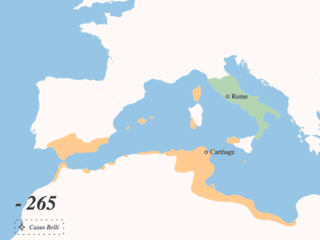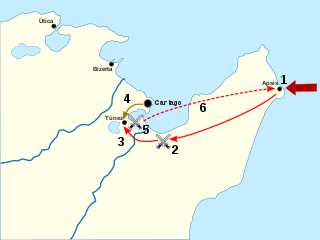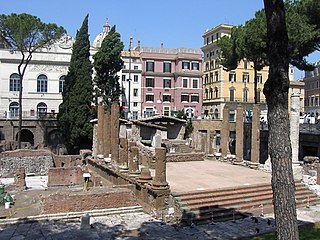
The First Punic War was the first of three wars fought between Rome and Carthage, the two main powers of the western Mediterranean in the early 3rd century BC. For 23 years, in the longest continuous conflict and greatest naval war of antiquity, the two powers struggled for supremacy. The war was fought primarily on the Mediterranean island of Sicily and its surrounding waters, and also in North Africa. After immense losses on both sides, the Carthaginians were defeated.

The Punic Wars were a series of wars between 264 and 146 BC fought between Rome and Carthage. Three conflicts between these states took place on both land and sea across the western Mediterranean region and involved a total of forty-three years of warfare. The Punic Wars are also considered to include the four-year-long revolt against Carthage which started in 241 BC. Each war involved immense materiel and human losses on both sides.
Hamilcar Barca or Barcas was a Carthaginian general and statesman, leader of the Barcid family, and father of Hannibal, Hasdrubal and Mago. He was also father-in-law to Hasdrubal the Fair.

The siege of Carthage was the main engagement of the Third Punic War fought between Carthage and Rome. It consisted of the nearly-three-year siege of the Carthaginian capital, Carthage. In 149 BC, a large Roman army landed at Utica in North Africa. The Carthaginians hoped to appease the Romans, but despite the Carthaginians surrendering all of their weapons, the Romans pressed on to besiege the city of Carthage. The Roman campaign suffered repeated setbacks through 149 BC, only alleviated by Scipio Aemilianus, a middle-ranking officer, distinguishing himself several times. A new Roman commander took over in 148 BC, and fared equally badly. At the annual election of Roman magistrates in early 147 BC, the public support for Scipio was so great that the usual age restrictions were lifted to allow him to be appointed commander in Africa.

The Battle of the Lipari Islands or Battle of Lipara was a naval encounter fought in 260 BC during the First Punic War. A squadron of 20 Carthaginian ships commanded by Boödes surprised 17 Roman ships under the senior consul for the year Gnaeus Cornelius Scipio in Lipara Harbour. The inexperienced Romans made a poor showing, with all 17 of their ships captured, along with their commander.

The Battle of Cape Ecnomus or Eknomos was a naval battle, fought off southern Sicily, in 256 BC, between the fleets of Carthage and the Roman Republic, during the First Punic War. It was the largest battle of the war and one of the largest naval battles in history. The Carthaginian fleet was commanded by Hanno and Hamilcar; the Roman fleet jointly by the consuls for the year, Marcus Atilius Regulus and Lucius Manlius Vulso Longus. It resulted in a clear victory for the Romans.
The naval Battle of Drepana took place in 249 BC during the First Punic War near Drepana in western Sicily, between a Carthaginian fleet under Adherbal and a Roman fleet commanded by Publius Claudius Pulcher.

The Mercenary War, also known as the Truceless War, was a mutiny by troops that were employed by Carthage at the end of the First Punic War (264–241 BC), supported by uprisings of African settlements revolting against Carthaginian control. It lasted from 241 to late 238 or early 237 BC and ended with Carthage suppressing both the mutiny and the revolt.

The Battle of the Bagradas River, also known as the Battle of Tunis, was a victory by a Carthaginian army led by Xanthippus over a Roman army led by Marcus Atilius Regulus in the spring of 255 BC, nine years into the First Punic War. The previous year, the newly constructed Roman navy established naval superiority over Carthage. The Romans used this advantage to invade Carthage's homeland, which roughly aligned with modern-day Tunisia in North Africa. After landing on the Cape Bon Peninsula and conducting a successful campaign, the fleet returned to Sicily, leaving Regulus with 15,500 men to hold the lodgement in Africa over the winter.

The battle of Adys took place in late 256 BC during the First Punic War between a Carthaginian army jointly commanded by Bostar, Hamilcar and Hasdrubal and a Roman army led by Marcus Atilius Regulus. Earlier in the year, the new Roman navy had established naval superiority and used this advantage to invade the Carthaginian homeland, which roughly aligned with modern Tunisia in North Africa. After landing on the Cape Bon Peninsula and conducting a successful campaign, the fleet returned to Sicily, leaving Regulus with 15,500 men to hold the lodgement in Africa over the winter.

The gens Lutatia, occasionally written Luctatia, was a plebeian family of ancient Rome. The first of the gens to obtain the consulship was Gaius Lutatius Catulus in 242 BC, the final year of the First Punic War. Orosius mentions their burial place, the sepulchrum Lutatiorum, which lay beyond the Tiber.
Lucius Valerius Flaccus was a Roman statesman and general during the middle era of the Roman Republic. He was one of the two consuls of 261 BCE, serving with Titus Otacilius Crassus. Together they fought in the ongoing First Punic War; they campaigned in Sicily. Before sailing to Sicily they strengthened the coastal defences of Italy against attacks by Hannibal Gisco, a Carthaginian admiral sent to raid the Tyrrhenian coast. The consuls besieged Mytistraton, but were eventually driven off by Hamilcar, the new commander of Carthage's Sicilian army, who inflicted a defeat on them at Thermae near Palermo. They returned to Italy were they started building a fleet. This fleet was the first Roman fleet of war ships ever and created after Carthaginian example. In 260, this fleet was ready.
Titus Otacilius Crassus was a Roman statesman and general during the middle era of the Roman Republic. He was one of the two consuls of 261 BCE, serving with Lucius Valerius Flaccus. During his consulship, he and his consular colleague Flaccus fought against the Carthaginians on Sicily as part of the ongoing First Punic War. Before sailing to Sicily they strengthened the coastal defences of Italy against attacks by Hannibal Gisco, a Carthaginian admiral sent to raid the Tyrrhenian coast. The consuls besieged Mytistraton, but were eventually driven off by Hamilcar, the new commander of Carthage's Sicilian army, who defeated them at Thermae near Palermo. They returned to Italy were they started building Rome's first warfleet, created after Carthaginian example. In 260, the fleet was ready and would be used by Gnaeus Cornelius Scipio Asina, one of the two consuls of that year.
The Roman withdrawal from Africa was the attempt by the Roman Republic in 255 BC to rescue the survivors of their defeated expeditionary force to Carthaginian Africa during the First Punic War. A large fleet commanded by Servius Fulvius Paetinus Nobilior and Marcus Aemilius Paullus successfully evacuated the survivors after defeating an intercepting Carthaginian fleet, but was struck by a storm while returning, losing most of its ships.

Aulus Manlius Torquatus Atticus was a politician during the Roman Republic. Born into the prominent patrician family of the Manlii Torquati, he had a distinguished career, becoming censor in 247 BC, then twice consul in 244 and 241 BC, and possibly princeps senatus in 220 BC. Despite these prestigious magistracies, little is known about his life. He was a commander who served during the First Punic War, and might have pushed for the continuation of the war even after Carthage had sued for peace following the Roman victory at the Aegate Islands in 241 BC. The same year, he suppressed the revolt of the Faliscans in central Italy, for which he was awarded a triumph. At this occasion, he may have introduced the cult of Juno Curitis at Rome.
Gnaeus Cornelius Blasio was a Roman statesman and general during the middle era of the Roman Republic. He was one of the two consuls of 257 BCE, serving with Gaius Atilius Regelus. Blasio was considered a princeps of the Senate. He was consul during the First Punic War against Carthage. During his consulship he commanded the Republic's land forces on Sicily, while his fellow consul Regelus led the fleet. He did not achieve any stunning victories, but instead focused on consolidating Rome's power on the island.
Marcus Aemilius Paullus was a Roman statesman and general during the middle era of the Roman Republic. He was one of the consuls of 255 BCE, serving with Servius Fulvius Paetinius Nobilior. As consul Paullus led the Republic's forces in the ongoing First Punic War against Carthage; he and Paetinus led a Roman fleet of 350 warships to Africa to rescue the remnants of the army of proconsul Marcus Atilius Regelus, who had been defeated in the Battle of the Bagradas River earlier that year. Onroute they defeated a Carthaginian fleet of 200 warships in the Battle of Cape Hermaeum.
Gaius Sempronius Blaesus was a Roman statesman and general during the middle era of the Roman Republic. He was one of the two consuls of 253 BCE, serving with Gnaeus Servilius Caepio. He was consul during the First Punic War against Carthage. During his consulship Blaesus led a Roman fleet to Africa and pillaged the Libyo-phoenician coast all they way to the island of Menix before sailing back to Italy via Panormus on Sicily. On his way back to Italy his fleet was hit by a violent storm sinking 150 ships.
Gnaeus Servilius Caepio was a Roman statesman and general during the middle era of the Roman Republic. He was one of the two consuls of 253 BCE, serving with Gaius Sempronius Blaesus. He was consul during the First Punic War against Carthage. During his consulship Servilius Caepio commanded Rome's land forces on Sicily, while his consular colleague led a fleet to Africa.
Publius Servilius Geminus was a Roman statesman and general during the middle era of the Roman Republic. He was one of the two consuls of 252 BCE, serving with Gaius Aurelius Cotta. They fought against the Carthaginians in the ongoing First Punic War; Geminus and Cotta were very successful; they took several Carthaginian strongholds on Sicily. In 248 he obtained the consulship a second time, together with his former colleague, Aurelius Cotta, and again fought in Sicily against the Carthaginians.










